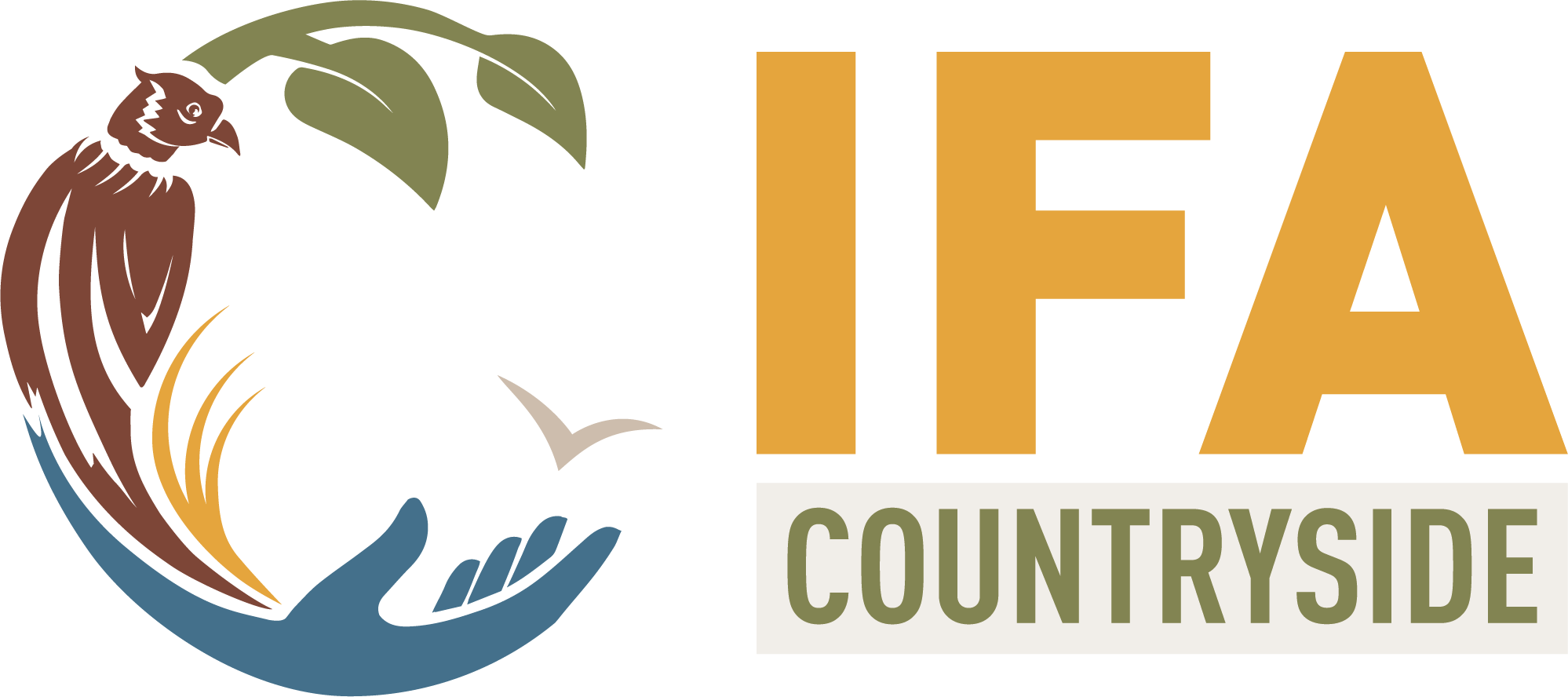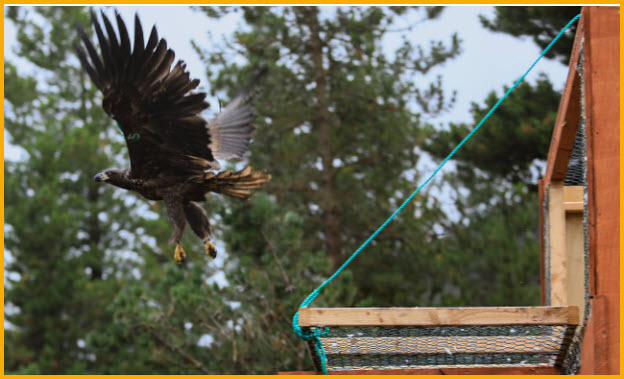A significant milestone has been reached with the re-introduction of White-Tailed (Sea) Eagles to Ireland this month, as twenty one chicks were released into the wild. There was a peaceful, easy feeling among staff of the National Parks and Wildlife Service (NPWS) at the Department of Housing, Local Government and Heritage – who have been looking after the eagles since they came to Ireland from Norway on June 25th of this year – as all birds took flight.
The twenty-one Norwegian-born Eagle chicks were released into the wild at the four Munster sites – on the Shannon Estuary, Lough Derg, Waterford and in Killarney National Park. It is hoped they will bolster Ireland’s existing White-Tailed Eagle population.
The chicks have been kept in purpose-built enclosures at the four locations while they grew, matured, and developed the feathers and muscles necessary for flight. They were carefully monitored and tagged by NPWS staff leading the collaborative reintroduction programme, which began in 2007. The satellite tags will allow the project to monitor their progress and their integration into the existing Irish breeding population
The chicks were collected under licence in June from nests throughout the Trondheim area of West-Central Norway by the Norwegian Institute for Nature Research (NINA). Their release is part of the second phase of the highly successful project to reintroduce this magnificent, iconic bird back to Irish skies.
Once a conspicuous part of Ireland’s landscape, they were driven to extinction by human persecution here in the late Nineteenth Century, a development which the Programme seeks to reverse. Restoring this lost flagship species to Irish skies will be a significant step in restoring Ireland’s natural heritage and will bring great benefit to Irish biodiversity, and in so doing will also contribute significantly to the economic, tourism and local communities – and indeed to human wellbeing. It underlines in practical terms Ireland’s commitment to implementing the UN Convention on Biological Diversity.
Two Phases
The first Phase ran from 2007-2011, managed by the NPWS and the Golden Eagle Trust, when 100 chicks were released into the wild. Since then, over 35 Irish-born chicks have fledged here, some of whom have begun to rear their own chicks. Indeed, this year one nesting pair on Lough Derg produced three chicks. This is uncommon, even in the very extensive wild populations in Norway.
The project has seen some setbacks alongside its success, and the vulnerability of the population to poisoning, alongside negative impacts due to Avian Influenza in 2018 and Storm Hannah in 2019 prompted the initiation of the Project’s Second Phase.
This Second Phase, managed by NPWS Regional Manager Eamonn Meskell with the advice of Dr. Allan Mee, will secure the substantial gains of the first phase of the Programme and expand the range of the existing population, which has so far nested in sites in Kerry, Cork, Tipperary, Galway, and Clare.
The Second Phase was launched last year, when ten Norwegian-born chicks were flown into Ireland and released into the wild on the Shannon Estuary and Lough Derg. Of these ten, an astonishing nine are still alive, and have travelled throughout the country, with one even travelling to Scotland. The success of last year’s release was thanks to the hard work of NPWS and the input and assistance of other interested parties, including representatives of the Irish Farmers Association (IFA), the Norwegian Institute for Nature Research (NINA) and, in particular, local landowners and farmers, without whose enthusiastic support in monitoring nest sites and care of birds the project could not succeed. Farmers are once again being asked to help in any way they can, with small measures such as the removal (or burial) of animals/pests killed by lead shot and also the safe use of Rodenticide.
The recent successes of the Project represent the ongoing cooperation of these different groups who are seeking to restore a lost element of Ireland’s natural heritage.
Minister for Heritage and Electoral Reform, Malcolm Noonan TD paid tribute to the collaborative approach. “The success of this project depends on the collaboration of many groups, including our NPWS teams, local farmers, conservationists and communities, the Norwegian Authorities and many other partners in Norway. These iconic birds would not have taken flight this weekend were it not for their collective efforts. I’d like to pay tribute to all involved and acknowledge their commitment to making this project a success, now and in the years to come.”
He continued: “White-tailed eagles are magnificent birds and, as top predators, they also play a key role in the functioning of ecosystems. I was privileged to release six of these stunning creatures last year in Kerry and I can honestly say that watching them soar through the skies on their first Irish flight is a memory that will stay with me for the rest of my life. I’d like everyone in Ireland to have the opportunity to observe this once-extinct species in its natural habitat.”
Returning this lost flagship species to Irish skies will be a huge step in restoring Irish natural heritage and improving Irish conservation efforts, and will benefit Irish biodiversity more broadly.
The re-establishment of breeding White-tailed Eagles at sites like Lough Derg and Killarney National Park has proven hugely popular with local residents, while the potential for economic benefits from sensitive, sustainable ecotourism was experienced in Mountshannon, Co. Clare, when the first breeding pair nested within sight of the village in 2012, attracting thousands of visitors. In 2020, the live-streaming of a White-tailed Eagle nest in Glengarriff, Co. Cork, proved to be a huge attraction, making the recent BBC list of the top 20 virtual nature attractions in the world.
Last year’s releases also saw considerable attention, sparking interest and widespread support nationally. Last year, Minister of State for Heritage Malcolm Noonan, and the acting Norwegian Ambassador to Ireland Arne Follerås, who both played a substantial role in ensuring the project’s success, attended the release on Lough Derg. Minister Noonan has checked in on the latest arrivals a number of times before their release this weekend.
Editor’s notes
- The Irish White-tailed Sea Eagle Reintroduction Programme is a long-term initiative to re-establish a population of this extinct species in the Republic of Ireland managed by the National Parks & Wildlife Service (NPWS) of the Department of Housing, Local Government and Heritage. Releases of birds (Phase 1) saw 100 young eagles release over five years (2007-2011) in Killarney National Park, Co. Kerry. As Sea Eagles breed at about five years old it was expected that the first Irish nesting attempts would be in 2012/2013.
- In 2012 the first nesting attempt occurred in Co. Clare, the first breeding in the wild in over 100 years. In 2013, the first wild-bred chicks fledged successfully from a nest in Co. Clare. However, a scientific review of the reintroduction project indicated the small population is still vulnerable to mortality factors such as illegal poisoning while the breeding population was negatively impacted by Avian Influenza in 2018 and Storm Hannah in 2019. The result was a decision to initiate a Second Phase of the project, which would see about 50 more eagles introduced from Norway to Ireland with the help of Norwegian partners, and would bolster and consolidate the gains of the existing population.
- Historically, the White-tailed Sea Eagle was once a conspicuous part of the Irish landscape, before it was driven to extinction in the 19th and early 20th century by human persecution.
- White-tailed Eagles feed primarily on fish and waterbirds, and carrion (dead animals). Thus, most pairs settle on territories around the coast and large freshwater lakes to breed.
- These birds rely heavily on carrion in the Winter and the first year before they learn to hunt for themselves. Because of this, they are particularly vulnerable to various forms of illness and poison.
- One of the birds released last year on Lough Derg became very sick from lead poisoning, and was only saved through human intervention and months of careful care and rehabilitation before its re-release into the wild. It was more than likely as a result of eating foxes which had been killed with lead shot and left out in the open. While clearly there was no intention to harm an eagle, this illustrates the potential for accidental poisoning of eagles, so if landowner/farmers are shooting animals – particularly in the coming months – please ensure that corpses are properly disposed of (for example, buried or otherwise hidden from birds of prey), so that the Eagles do not contract lead poisoning from them.
- Eagles have been affected by Rodenticide poisoning, likely picked up from dead or dying poisoned mammals. There is a comprehensive set of resources on the safe use of Rodenticide produced by the Campaign for Responsible Rodenticide Use, available at http://www.crru.ie/
- Over the past 13 years White-tailed Sea Eagles have dispersed throughout Ireland and beyond. Although most have remained in Ireland, some have been reported from Northern Ireland and at least seven birds have been recorded in Britain.
- In 2020 at least ten White-tailed Eagle pairs held territory in Ireland across four counties: Kerry (7 pairs), Galway (1), Tipperary (1) and Cork (1).
- At least nine pairs laid eggs in Kerry (6 pairs), Cork (1), Tipperary (1) and Galway (1).
- White-tailed Eagle chicks were collected under licence in Norway by the Norwegian Institute for Nature Research (NINA) and transported to Ireland for release in June 2020 and June 2021.
- Phase II releases began in 2020 with the collection of an additional 10 birds from nest in Norway and their release some 6-8 weeks later in SW Ireland: at Lough Derg, Co. Tipperary and the Shannon Estuary.
- This year, 23 birds were collected from nests in Norway and have been kept at locations on the Shannon Estuary, Lough Derg, and in Waterford and Killarney National Park.
- Birds will be tagged, including with satellite tags, before release to allow the project to monitor their progress, collect scientific biological data and follow their integration into the existing Irish breeding population
- An important aspect of any such releases is cooperation with the farming communities in the release areas and where birds settle to breed. During the first phase of the release project, managed by the NPWS and the Golden Eagle Trust, and during last year’s Phase II re-introduction, a good relationship was established in the release and breeding areas with the farming community, so much so that farmers helped monitor birds and nests at some sites. The Phase II release hopes to build on this relationship into the future to ensure that farming and eagles continue to coexist to their mutual benefit.

